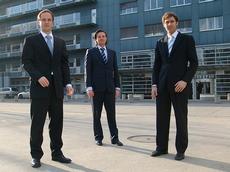Preventing what can ruin a company
Parallel doctorates on related subjects were the inspiration behind the idea of three young entrepreneurs to set up a risk assessment consulting service. Work has been flooding in – thanks in no small part to the new Swiss Code of Obligations.

Every company faces a certain amount of risk. However, not all of these dangers would actually threaten the company’s existence if they actually arose. The ETH Zurich spin-off i-Risk investigates the hazards that could ruin a company and finds ways of avoiding them, as well as helping to develop a risk management strategy.
“The orders started rolling in thick and fast right from the outset”, delights Berthold Barodte, one of the three company founders. Co-founder Eric Montagne adds: “This was because all three of us were lucky enough to complete our doctorates in risk management at the D-MTEC in the summer of 2008, which made founding the company fairly straightforward. Many of the companies we’d been in contact with for our theses had already asked what would happen after we finished our PhDs.”
Barodte, Montagne and the third member of the team, Adrian Fischer, all did PhDs with Roman Boutellier, Professor of Technology and Innovation Management, in the Department of Management, Technology and Economics (D-MTEC). Today, Boutellier is on the advisory board of the young company.
The young entrepreneurs’ theses complimented each other perfectly. The focuses of the three dissertations were the influence of the human factor in risk management, the implementation of preventative and reactive measures in utily companies and the adaptation of risk management to the conditions of medium-sized companies.
Welcome change to Code of Obligations
The majority of i-risk’s clients are medium-sized companies like Karl Vögele, Möbel Märki or Pneu Egger. However, the three young entrepreneurs have also already implemented projects for large companies like Emmi, Swiss Railway (SBB) or Swiss International Airlines. The reference list currently boasts over forty companies. A major factor in their initial success was an opportune change to the Swiss Code of Obligations that became effective for the 2008 financial year and made their services attractive to any company of a certain size: Article 663b OR now requires companies to submit a risk assessment with their annual accounts.
i-Risk’s work is based on intensive interviews and workshops with the management and experts from the particular firm in question to determine the potential dangers for the company. i-Risk also peruses checklists of items that the company thinks pose risks in important points. Eric Montagne explains the procedures: “First, we sit down with the management to analyze what could prevent them from achieving their predefined three-year objectives. We then reduce the answers to about twenty points that we substantiate in workshops.” In doing so, they discuss everything from the likelihood of a fire breaking out in the production plant to the risk of missing a trend.
Making sure that everyone is in the same ballpark
In each case, it is important to ascertain just how serious the consequences would be for the business routine. They start by tackling the largest risks – no mean feat, for it often turns out that people are talking about different things. Montagne: “The classic scenario is IT failure. For one person, this might mean a two-hour breakdown – it happens more frequently but does not really threaten the business. Meanwhile, his colleague is envisaging a two-day crash – the chances of this happening are considerably lower but the consequences would be disastrous.”
It is i-Risk’s job to ensure that everyone proceeds from the same starting point and can then work together to identify the most serious risks. Now the root-cause-analysis can be carried out. i-Risk uses this to develop the necessary processes to neutralize the risks as far as possible. To this end, they work with the corporate management to determine which member of staff does what and when. A risk management software tool partially of their own devising helps to monitor the implementation of these processes.
Develop recall plan
Berthold Barodte is aware how abstract this sounds. He uses the example of a toothbrush manufacturer to explain the procedure: “For our customers, a large-scale product recall would have disastrous consequences. The specialists from the production department know that the piece connecting the handle and the brush head has to be a certain thickness if you don’t want the head to break off somewhere down the line. It stands to reason that you consider this as part of quality management.” The company in question did not see any need for this, however. Barodte: “It turned out that they didn’t have a recall plan to withdraw faulty goods from the market quickly and without fuss.” i-Risk was able to help them with this.
Expansion on the cards
The young company started so well that the three entrepreneurs are already making plans for the distant future. The most important one: “We definitely want to get more people involved”, admits Barodte smiling. i-Risk will take this one step at a time. They want to involve PhD students in the future. Furthermore, they are looking to expand their business field. Montagne: “Being familiar with the risks a company faces, we also find out a lot about its opportunities.” Consequently, they are also looking to establish themselves in strategy consulting in the future.







READER COMMENTS